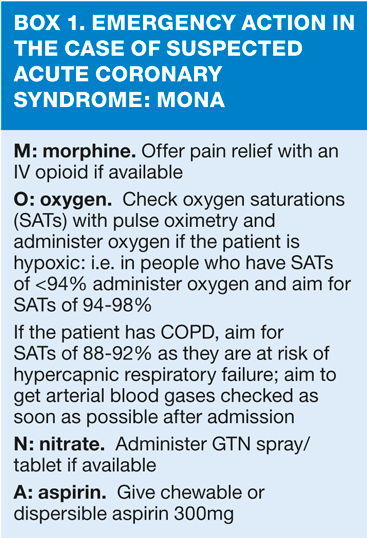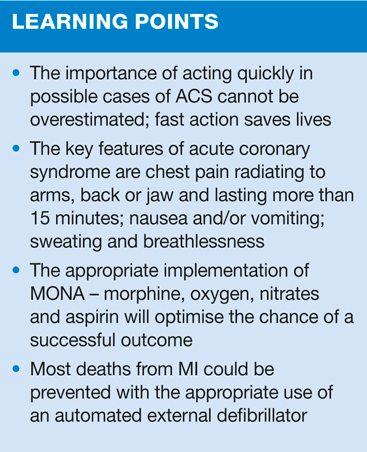Dealing with emergencies in general practice The patient with suspected acute coronary syndrome
Beverley Bostock-Cox
Beverley Bostock-Cox
RGN, BSc, MSc
Nurse Practitioner, Sky Blue Medical Group, Coventry, Clinical Lead, Education for
Health, Warwick
Knowing what to do if a patient collapses in the surgery — or in a public place — with a suspected myocardial infarction can literally make the difference between life and death. In the second article of this series, we discuss what steps the practice nurse should take in a medical emergency
In a previous article on dealing with emergencies in general practice, we discussed the key skills required when coping with an emergency situation, including how to carry out effective life support.1 In this and future articles, we will discuss specific emergency situations and how to act safely and effectively in each situation. This article describes how to recognise the patient who may be suffering from acute coronary syndrome and explains the importance of acting swiftly to optimise the outcome and safeguard the heart — 'time is tissue'.
Acute coronary syndrome (ACS) is an umbrella term which covers myocardial infarction (MI) and unstable angina, both of which are potentially fatal.2 According to the British Heart Foundation3 there were over 100,000 heart attacks in England in 2007 and over half of these occurred in people under the age of 75. Over 1.2 million people have had an MI at some point in their lives. As nurses, we are expected to act in the event of an emergency and this will not necessarily be in the relative comfort of the surgery, surrounded by our colleagues. While leaving the station after a recent train journey, I realised that a man had collapsed on the train opposite mine and staff were calling for any nurses and doctors in the station to attend and help. It was a timely reminder that we are never 'off duty' and should always be able to offer assistance, within the boundaries of our competence, in situations such as this.
Any delays in making a diagnosis of ACS can result in death; at the very least there is significant risk of permanent damage to the heart muscle leading to subsequent heart failure. Fast and effective assessment will provide the essential information that will allow the clinician to recognise the urgency of the situation and act accordingly.
Although it is true to say that no two heart attacks are the same, there are some classic elements seen in the presentation of an acute MI which should alert the observer to the possibility that this is in fact the diagnosis. A typical presentation could include chest pain - typically crushing central chest pain radiating out to the jaw, arms and back, dizziness, difficulty breathing, sweating, nausea and/or vomiting and possible loss of consciousness.
ACT FAST, DIAL 999
Asking the patient or a relative to describe what happened in the time leading up to the event can be very useful. However, if the patient is acutely unwell and distressed, the first thing to do is dial 999 and take emergency action as detailed in Box 1.4
If possible, a more detailed history can be obtained whilst waiting for emergency assistance. One quick assessment tool that can be used to assess for the likelihood of ACS is the PQRST tool.5
P: provocative and palliative. Elements that bring on and/or relieve the pain. In an acute MI, the patient may say that the pain came on with exertion and was relieved by resting. This is typical of ischaemic pain. In those patients who already have a diagnosis of coronary heart disease, they may have tried to use their GTN spray with limited or no relief.
Q: quality of the pain. In an MI the pain is typically described as a crushing, squeezing band of pressure. This is different from, for example, the electric shock type pain associated with nerve pain or neuralgia.
R: region and radiation. The pain of an MI is usually central and retrosternal; it may then radiate out into the arms, the armpits, the neck, jaw or back.
S: severity. Although many people describe the pain as being intense and severe, others may describe a much milder type of pain which they may even mistake for indigestion. Women are known to have atypical presentations of an MI more often than men and the so-called 'silent MI' may be seen in people with diabetes.6
T: timing. Knowing when the pain started and how long it lasted can help to ascertain whether or not a cardiac cause is likely. Pain that has gone on for more than 24 hours is unlikely to be cardiac.
Investigations for cases of suspected ACS were discussed in a previous article;7 however, it is worth reiterating in brief here. NICE states that although the most important investigation in suspected ACS is an ECG, admission to hospital should not be delayed in order for an ECG to be carried out,4 especially as studies have shown that a single ECG can provide limited or misleading information.8 Blood pressure, oxygen saturations and pulse rate and rhythm should be monitored if possible. Other tests, such as troponin t levels should be carried out in hospital.9
If the patient collapses at any point, emergency life support using cardiopulmonary resuscitation and the use of an automated external defibrillator will be necessary. Approximately two thirds of deaths caused by myocardial infarction occur in the first hour. Most of these deaths could be prevented with defibrillation. (Box 2) As discussed in the previous article1 the chance of surviving a cardiac arrest increases significantly if a defibrillator is used within the first five minutes of a person collapsing.10
CONCLUSION
Coronary heart disease remains a cause of significant morbidity and mortality in the UK. Acute coronary syndrome can be fatal especially if the opportunity to take fast, effective action is missed. All health care professionals should have up to date training in basic life support and should be aware of the key actions to take in cases of suspected acute MI. These actions include knowing when to initiate morphine, oxygen, nitrates and aspirin appropriately.
Next time — What to do in the case of suspected stroke.
REFERENCES
1. Bostock-Cox B Emergencies in general practice Practice Nurse 2012;42(17):22-25
2. British Heart Foundation (2012) Heart disease facts Available from http://www.bhf.org.uk/media/news-from-the-bhf/bhf-facts.aspx Accessed January 2013
3. British Heart Foundation (2012) England CHD Statistics Factsheet Available from www.bhf.org.uk/statistics Accessed January 2013
4. NICE (2010) CG95 Chest pain of recent onset: quick reference guide Available from http://guidance.nice.org.uk/CG95/QuickRefGuide/pdf/English Accessed January 2013
5. Roche B (1998) Assessment by PQRST checklist Available from http://www.wemsi.org/pqrst.html Accessed January 2013
6. Eden BM Chest pain in women: What's the difference? Nurse Pract. 2008; 33(2):24—34.
7. Bostock-Cox B Assessing chest pain in primary care Practice Nurse 2012;42(14):34-38
8. Snow V, Barry P, Fihn SD et al. Evaluation of primary care patients with chronic stable angina: guidelines from the American College of Physicians. Ann Intern Med 2004; 141:57—64.
9. Achar SA, Kundu S and Norcross W. A Diagnosis of Acute Coronary Syndrome Am Fam Physician. 2005; 72(01):119-126.
10. British Heart Foundation (2012) Defibrillators Available from http://www.bhf.org.uk/heart-health/life-saving-skills/defibrillators-save-lives.aspx Accessed January 2013
Related articles
View all Articles


